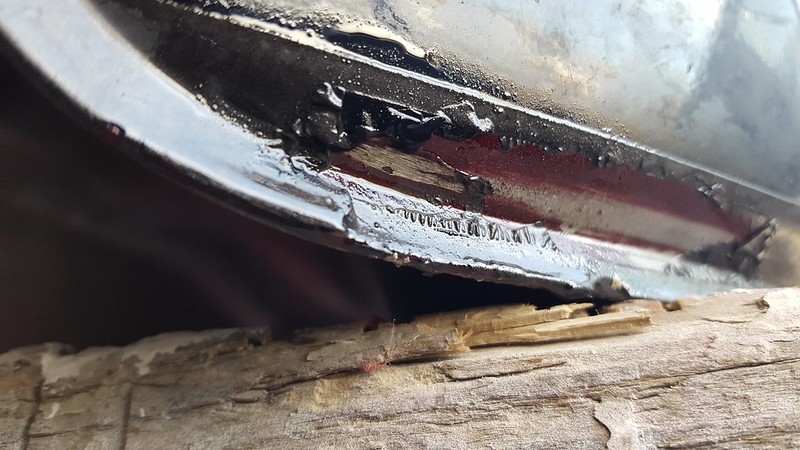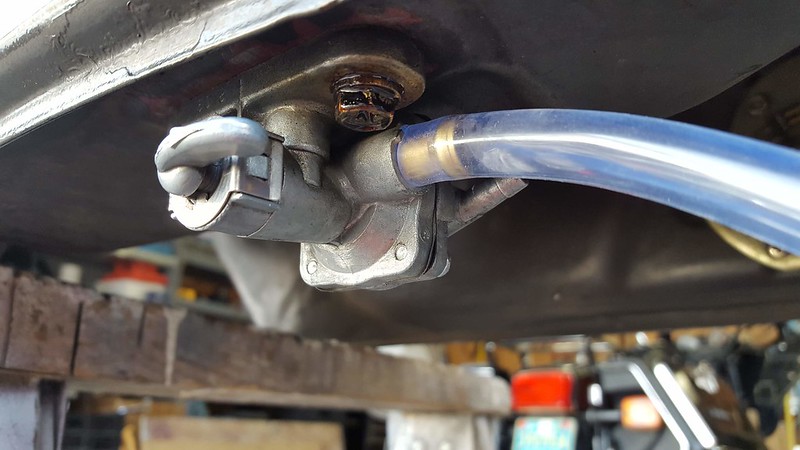FIRST THING: None of these kits will work properly unless you follow the instruction for use exactly. Don't skip steps and don't rush through any of the steps. If you do, you will have wasted your time and your tank will not be properly sealed.
NOTE 1: If you have a tank that was previously sealed but the old sealant is failing, you will need the POR-15 Motorcycle Fuel Tank STRIP and Repair Kit, which also contains a stripper to remove the old failing sealant first.
NOTE 2: A very easy way to plug large round openings in the tank is to use Oatley Test Plugs. They are available in various sizes in the plumbing section of Home Depot or Lowe's.
OK, here are my personal instructions for success with the POR-15 Motorcycle Fuel Tank Repair Kit:
The very first thing to do is to determine just how extensive your tank rust is. If there are just a few spots throughout the tank that are rusted (usually at the bottom) then the POR-15 kit's second step (Metal Prep solution) will be sufficient to remove the rust. However, if you have a tank that is almost all rusty inside, then you have to de-rust that tank with something else before starting with the POR-15 kit. This kit, and most others as well, do not have enough rust remover to deal with an entire tank full of rust.
The best and most safe rust remover I've used is "EvapoRust". Not caustic and you can safely pour it down the drain when its used up. It can be re-used until it's very dark in color, almost black, which means it can't take any more rust. Not all auto parts stores carry it. O'Reilly's is the only one around here that carries the gallon jugs of it. It's expensive, so buying it by the quart is not the way to go. A gallon costs over $20.00. But it's worth it. The stuff is amazing. I usually buy enough to fill half the tank. I pour the two gallons or so in the tank and let it sit in various positions for at least several hours at a time. Back down- front down - bottom down - left side down - right side down - top down. So that means you'll have the stuff in there for probably two whole days. This will get rid of the 99% of the rust.
Don't rinse the EvapoRust out of the tank with water until you're ready to start with the POR-15, otherwise the tank will quickly flash-rust. Once rinsed out with lots of plain water, you are ready to start with the POR-15 Kit.
The POR-15 kit actually comes with pretty good instructions, but I will expand upon those and hopefully my experience using the kit will help others.
The first stage is the Cleaner/Degreaser (used to be called "Marine Clean" in the older kits). This is mixed with a quart of warm water and then goes in the tank and gets sloshed around manually for 20 minutes and then rinsed out with water. Cleaner/Degreaser removes the gum and varnish deposits from the old fuel that was in the tank.
The second stage is the Metal Prep. This is the POR-15 rust remover. It also prepares the metal for sealing by making it acidic. This goes in the tank and gets sloshed around manually for 20 minutes. After the sloshing, you have to let the tank sit in various positions again for about 15 to 20 minutes each to let it act on each inside surface of the tank to remove any remaining rust. POR-15 instructions say to not let it in the tank longer than 2 hours total. Remember that this is only a quart of stuff that you put in a 3 to 5 gallon gas tank, depending on model. So it needs to be positioned so that the stuff contacts each surface inside the tank for 15 to 20 minutes. Then you have to rinse that stuff out with WARM water, not cold water from a hose. It has to be rinsed SEVERAL times to be sure to get all of the Metal Prep solution out.
Now the most important step that can screw the whole thing up if not done right. The tank must now be COMPLETELY DRIED before the Sealer is poured in. There are going to be spots in the tank that hold water but you've got to spend the time to get it bone dry inside. The recommended way to dry it is to open all of the plugged holes in the tank and use a hair dryer or a hot air gun to blow hot air into the gas tank filler hole. If you decide to use a hot air gun, be careful, you can melt the paint right off your tank if you're not careful. Best to use a hair drier for this. Also, I've learned to do these tank restorations outdoors on a hot sunny day. The hot sun is a great help in this drying process. In between sessions of blowing hot air into the tank with a hair dryer I let the gas tank bake in the sun for 10 to 15 minutes at a time. TIP: If after about a half an hour, between the hair dryer and baking in the sun, your tank is so hot that you can't pick it up with your bare hands for more than a few seconds, you can be pretty sure that it is bone dry inside. That's how I measure success when drying. If it's not bone dry and you pour in the tank sealant, it's not gonna stick to the metal and you get to star all over! (You don't want that because this sealant is nasty, like liquid metal, and doesn't clean up well at all.)
NOTE: Once the tank is completely dry, you'll notice that flash-rust (a light reddish-brown surface color on the metal) will have already started to form inside the tank. Don't fret, that's normal and there's nothing you can do about it. The Tank Sealer will adhere to and seal the tank with the flash-rust on it. Just don't wait for very long after the tank is dry to start the Fuel Tank Sealer process.
Last stage is the Fuel Tank Sealer. You want to start this as soon as the tank is completely dry because flash-rust will start forming. As mentioned this is like liquid metal and it's nasty to get off of stuff, like your fingers and your gas tank! Wear some rubber gloves. If you get it on your tank and don't wipe it off immediately you're in trouble. If you get any on your fingers, get it off or else you'll be getting it on everything that you touch. It's best to cover at least the top of your tank about 6" to 8" around the filler hole with something. I use painters tape. It holds good enough to keep out the goop, but not so tight that it may pull the paint off of a very old tank. Don't use duct tape on the painted surfaces of your tank! I've had duct tape pull paint off of an old tank before! Use an old funnel to pour the sealer into your tank. If you miss and pour some on the tank, you're gonna be mad. Use an old funnel that you can throw out when you're done, or make a funnel out of paper like I do, then just throw that out. Now seal up the filler hole and do the SLOW ROLL. You have to slowly roll the tank into all possible positions to get the sealer to cover the entire inside of the tank. SLOW roll is the operative phrase. The stuff is thick like molasses so if you roll too fast it can't keep up. Roll nice and slow. I usually roll for about 10 to 15 minutes total.
Last important step is to get any remaining sealer drained out of the tank. If you have any excess, it will pool in the tank usually down low, and that's a bad thing. It can refuse to harden and may block fuel flow. You can usually get it to drain out of the fuel petcock hole. That usually works. Sometimes you just can't get it all out of the fuel petcock hole but you can still see some pooling through the gas tank filler hole if you tip the tank in the right direction. A time or two I had to use some small pieces of paper towels (about 4" x 4") inserted into the tank with a long-neck parts grabber to soak up some of the excess that wouldn't drain out of the fuel petcock hole. If you do this, be sure to use heavy duty shop paper towels, not the wimpy white ones from your kitchen. Those might rip and then you'll be fishing pieces of paper out of your tank. Also be careful not to get any sealer on your tank when you pull the paper towels out of the filler hole. Have something ready to drop the sealer coated paper towels into when you take them out. Like I said the stuff is nasty to clean up once its on something.
Be sure to rinse the sealant off of your Oatley test plug(s) as soon as you remove them from the tank or you'll never be able to reuse it. Also, don't be tempted to rinse sealant off of anything in a sink in your house! This stuff dries hard like metal and you don't want it in your house drains. Mama won't be happy! Do all your rinsing outside with a hose.
Now the tank has to cure for at least 4 days before you can put fuel in it. Don't short change the curing time. 4 days minimum! Setting it somewhere in direct sunlight helps the curing process. All plugged holes should be open for curing.
So... those are my lessons learned and tips from doing several tanks with the POR-15 Kit. Hope that helps others get their tanks cleaned and sealed properly.
POR-15 Kit and Tank.jpg
.png)


Comment